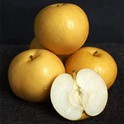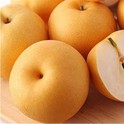Hey there, fellow fruit enthusiasts! As a yellow pear supplier, I often get asked some pretty interesting questions. One that pops up quite a bit is, "Can you make wine from yellow pears?" Well, let's dive right into this juicy topic and find out!
First off, let's talk about the yellow pears we're dealing with. There are some really great varieties out there. Take the Juicy Pear, for example. It's super juicy, as the name suggests, and has a sweet and refreshing flavor. Then there's the Crown Juicy Pear, which has a bit of a regal touch with its unique shape and delicious taste. And of course, the Golden Pear Fruit, with its beautiful golden color and rich flavor. These pears are not only great to eat fresh but also have the potential to be turned into some amazing wine.
Now, to answer the big question: yes, you can absolutely make wine from yellow pears. In fact, pear wine, also known as perry, has been around for centuries. It has a long history in many parts of the world, especially in regions where pears grow abundantly. Just like grape wine, pear wine can vary in flavor, aroma, and style depending on the type of pears used, the fermentation process, and other factors.
So, how do you make wine from yellow pears? Well, it's not as complicated as you might think, but it does require a bit of patience and attention to detail. Here's a basic overview of the process:
Step 1: Selecting the Right Pears
The first step is to choose the right yellow pears for your wine. You want pears that are ripe but not overripe. Overripe pears can have a higher risk of spoilage and may not produce the best flavor. Look for pears that are firm, have a good color, and a sweet aroma. If you're using a mix of different varieties, like the ones I mentioned earlier, it can add complexity to your wine.


Step 2: Cleaning and Crushing the Pears
Once you've selected your pears, it's time to clean them thoroughly. Remove any stems, leaves, or blemishes. Then, crush the pears to release their juice. You can use a fruit crusher or a blender for this step. Make sure to get as much juice out of the pears as possible.
Step 3: Fermentation
After crushing the pears, transfer the juice to a fermentation vessel. You can use a glass carboy or a food-grade plastic container. Add yeast to the juice to start the fermentation process. Yeast converts the sugar in the pear juice into alcohol. You can use a wine yeast specifically designed for fruit wines or a general-purpose yeast. Keep the fermentation vessel in a cool, dark place and let the yeast do its work. This process can take anywhere from a few days to a few weeks, depending on the temperature and the type of yeast used.
Step 4: Clarification and Aging
Once the fermentation is complete, the wine will need to be clarified. This involves removing any sediment or solids from the wine. You can do this by racking the wine into a clean container, leaving the sediment behind. After clarification, the wine can be aged for a period of time to improve its flavor and aroma. Aging can take anywhere from a few months to a few years, depending on the style of wine you're making.
Step 5: Bottling
Finally, when the wine has reached the desired flavor and clarity, it's time to bottle it. Use clean, sterilized wine bottles and corks or screw caps. Make sure to label your bottles with the date, type of pears used, and any other relevant information.
Now, let's talk about the flavor profile of pear wine. Pear wine can have a wide range of flavors, from light and fruity to rich and complex. It often has a sweet, floral aroma with notes of pear, honey, and sometimes a hint of spice. The taste can be crisp and refreshing, similar to a white wine, or it can be more full-bodied and creamy, like a dessert wine. The style of wine you make will depend on the type of pears used, the fermentation process, and the aging time.
One of the great things about making wine from yellow pears is that it allows you to showcase the unique flavors of these delicious fruits. Pear wine can be a great alternative to grape wine, especially for those who are looking for something different. It's also a great way to use up any extra pears you might have at the end of the season.
As a yellow pear supplier, I'm always excited to see people getting creative with our pears. Whether you're a home winemaker or a professional vintner, I encourage you to give pear wine a try. Not only is it a fun and rewarding project, but it can also result in some truly amazing wine.
If you're interested in purchasing high-quality yellow pears for your wine-making adventures, I'd love to hear from you. We have a wide selection of the best yellow pear varieties, including the Juicy Pear, Crown Juicy Pear, and Golden Pear Fruit. Our pears are grown with care and attention to detail, ensuring the best flavor and quality.
So, if you're ready to start making your own pear wine or just want to learn more about our yellow pears, don't hesitate to reach out. Let's work together to create some amazing wine and enjoy the delicious flavors of yellow pears.
References
- "The Compleat Winemaker" by Jeff Cox
- "Making Fruit Wines: A Step-by-Step Guide" by Tim Patterson
- "The Wine Bible" by Karen MacNeil





